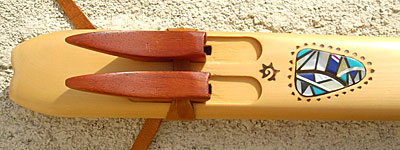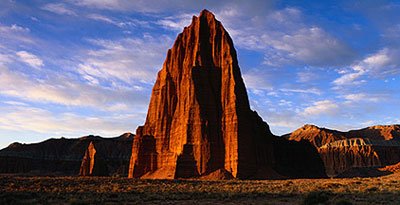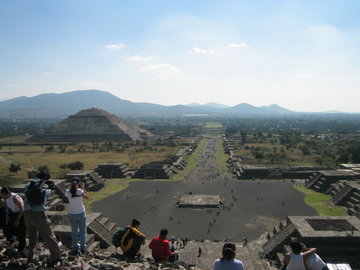
In this post we’re going to look at a Mayan Double flute made by Guillermo Martinez. I recorded this flute for a song called Temple of the Sun on my latest CD New Fire.
Based on Mayan design this is a very unusual flute as it is really two flutes in one. As you can see in the photo above there are finger holes on both sound chambers giving the player the ability to change the pitch on both flutes. The other style of flute that has two sound chambers are called Drone flutes, which we will look at in later postings.
Measurements and Tunings
The longer chamber is 24 1/2” long with a 1" bore, while the shorter one is 18 1/4” with a 3/4" bore. The two flutes are tuned a perfect 5th apart. The longer, lower flute is tuned to D, while the shorter one is tuned to A. The fingerings on each flute consist of the first four notes of the minor pentatonic scale: Root, Min 3rd, perfect Fourth and Fifth.

There are two thumbholes on the back the flute, one for each chamber, that play the interval of a minor 6th from the root note, when it and all the front holes are uncovered. This interval is not uncommon on flutes of Meso American design. The Mayan Moon Goddess flute discussed earlier also has a thumbhole that plays this interval.
The Wood

This flute is made from Alaskan Yellow Cedar with Padauk blocks. There is also beautiful inlay of turquoise, mother of pearl and jet.
The Flute
Alaskan Yellow Cedar is native to the west coast of North American from Alaska to northern California and was first identified on Vancouver Island, British Columbia. It tends to grow on the wet side of coastal mountains and is an evergreen tree. Scientists think essential oils from yellow-cedar heartwood may be a mosquito repellant. Its name is somewhat misleading as it is not a cedar but a cypress. It has many other names including Yellow Cedar, Alaskan Cedar and Nootka Cedar, from the native Nootka culture of Vancouver Island.
The Blocks
Padauk is native to Asia and Africa. The name is of Indonesian origin. It is a favorite with woodworkers for it's red color that fades to a warm brown when exposed to sunlight.
A Hybrid

Although based on Mayan design this flute is really an ingenious hybrid of Mayan design and Native American flutes from North America. The sound chambers are based on Mayan design, while the mouthpiece and sound mechanism are based on Native American flutes from North America.
Wood vs. Clay
Traditionally a Mayan double flute would be made out of clay, not wood, but Guillermo has chosen to use wood for his double flutes. Traditional Mayan flutes are made of clay due in part to the symbolism clay has with the four sacred element of Mother Earth. Earth mixed with water becomes the clay, which is then fired in a kiln. Then the player’s breath is the wind. Clay, however, is a very hard medium to work with. It shrinks during firing, which changing it’s tuning. It can also break or even explode during the firing possess. Wood, however, is very stable. It doesn’t shrink like clay, or explode.
Air Flow
The other major difference between this flute and a traditional Mayan flute is the construction of the sound mechanism or fipple. Like Penny whistles, Tin whistles and Recorders, traditional Mayan flutes have a mouthpiece that is directly connected to the sound hole, the hole next to the mouthpiece, called the fipple. Also traditional Mayan flutes don’t have the block that rests on top of Northern Native American flutes, which this flute clearly has.
Also this flute, like Native American flutes from North America, has an additional chamber in front of the fipple called the slow air chamber or the high-pressure wind chamber. The player blows into this additional chamber where the air builds up pressure. From there the air stream is forced into a slot located between the top of the flute and the bottom of the block toward the fipple. This design is vastly more complex than traditional fipple flutes and, to my knowledge, is unique to Native American flutes.
For a more detail look at the construction of the Native American flute read The History and Construction of the Native American flute article on www.cedarmesa.com
Temple of the Sun

The title of the song on which I recorded this flute, Temple of the Sun, takes it's name from one of a pair of sandstone monoliths in Lower Cathedral Valley in Capitol Reef National Park in southern Utah. The larger of the two is named Temple of the Sun, the smaller Temple of the Moon. Each of the temples is composed of the Jurassic Entrada Sandstone, which is approximately 160 million years old. This sandstone also makes up the arches and fins of Arches Natural Park.
Cathedral Valley is only accessible by high clearance or four-wheel drive vehicle, and as it's name would suggest it's spires and pillars of sandstone are reminiscent of the Gothic Cathedrals of Europe. During my last trip to Capitol Reef I made the rough and bone jarring trip to Cathedral Valley and that trip was part of the inspiration for the song Temple of the Sun.
Pyramid of the Sun

I was also inspired by The Pyramids of the Sun and Moon in the ancient city of Teotihuacan north of Mexico City. The name is Nahuatl and translates as "City of the Gods". The Pyramid of the Sun is the largest stone pyramid in all of Pre-Columbian Americas. When I purchased the flute from Guillermo the name he had given to this flute was Teotihuacan.
Mp3 Sample
Listen to Temple of the Sun from my latest CD New Fire
More information
For a more detail look at the construction of the Native American flute read the History and Construction article on www.cedarmesa.com.
For more information on the location and cultures of Meso America and their flutes, read the Mayan Moon Goddess flute post of this blog.
To find out more information about Guillermo Martinez's flutes, and other flute makers check out the FLUTE MAKERS page on my web site.
Capitol Reef lodging
Cowboy Homestead Cabins
Comments
Let me know if you enjoyed this post. Leave a comment below. Don't be shy.
Scott August
This was great! I've been wondering for quite some time which flute was responsible for "Temple of the Sun." The added naturalist details are also appreciated.
ReplyDeleteOsiyo Scott;
ReplyDeleteI was looking at Martinez's new signature flute and was happy to find some info. about the quality and workmanship of his Mayan flute. I am always very appreciative of quality information about Native American music,artists, flutemakers,flutes,etc. because it is very difficult to purchase a flute without holding it in my own hands and playing it. Every flute is a precious gift to myself and getting one that touches my spirit is blissful. Thank you for any and all the information you share.
peace;
Lakota (N.Virginia)
Your articles on flutes are very well done.
ReplyDeleteexcellent post Scott! as a flute maker, it is wonderful to see a masterpiece such as this modified drone, being played by a master. After reading the post and hearing how it sounded, i had to make one for myself.
ReplyDeleteI have it now, tuned and almost completed. can't say i can make it sound anything close to the sample above, but i have found inspiration through you. Thanks so much for sharing.
Where can I purchase this flute?
ReplyDeleteI thought it was some fancy drone at first. Actually a double flute. Amazing. Wonderful. Great sounds from it too, Scott.
ReplyDelete